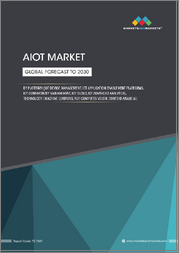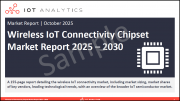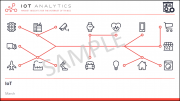
|
시장보고서
상품코드
1748788
IoT 커넥티비티 시장 : 세계 산업 규모, 점유율, 동향, 기회, 예측, 컴포넌트별, 용도별, 조직 규모별, 지역별, 경쟁별(2020-2030년)IoT Connectivity Market - Global Industry Size, Share, Trends, Opportunity, and Forecast, By Component, By Application, By Organization Size, By Region & Competition, 2020-2030F |
||||||
세계의 IoT 커넥티비티 시장 규모는 2024년에 98억 7,000만 달러, 2030년에는 281억 1,000만 달러에 달하며, CAGR 19.06%로 성장할 것으로 예측됩니다.
이 시장에는 제조, 운송, 에너지, 헬스케어, 스마트 시티 등의 산업에서 상호 연결된 IoT 기기 간의 원활한 통신을 촉진하는 기술, 플랫폼, 서비스가 포함됩니다. 여기에는 실시간 데이터 전송 및 상호운용성을 지원하는 셀룰러, Wi-Fi, LPWAN, 위성 등 유무선통신 프로토콜이 포함됩니다. 시장 성장의 원동력은 IoT의 급속한 확산, 하드웨어 비용의 하락, 자동화된 데이터베이스 의사결정에 대한 의존도가 높아진다는 점입니다. 기업은 IoT 솔루션을 도입하여 자산을 모니터링하고, 업무 효율성을 개선하고, 개인화된 경험을 제공하기 위해 IoT 솔루션을 도입하고 있습니다. 스마트 인프라에 대한 투자 증가, 5G 네트워크 구축, 엣지 컴퓨팅의 성장도 빠르고 안전하고 확장 가능한 연결에 대한 수요를 촉진하고 있습니다. 디지털 전환이 심화되고 인더스트리 4.0의 도입이 가속화됨에 따라 시장은 지속적으로 확대될 것으로 예측됩니다.
| 시장 개요 | |
|---|---|
| 예측 기간 | 2026-2030년 |
| 시장 규모 : 2024년 | 98억 7,000만 달러 |
| 시장 규모 : 2030년 | 281억 1,000만 달러 |
| CAGR : 2025-2030년 | 19.06% |
| 급성장 부문 | 중소기업 |
| 최대 시장 | 북미 |
시장 성장 촉진요인
가속화되는 산업 디지털화 및 스마트 제조에 대한 노력
주요 시장 이슈
대규모 IoT 네트워크의 데이터 프라이버시 및 보안 위험에 대한 자료입니다.
주요 시장 동향
IoT 커넥티비티 시장에서 지연 시간 단축을 위한 엣지 컴퓨팅의 확대
목차
제1장 솔루션의 개요
- 시장의 정의
- 시장의 범위
- 대상 시장
- 조사 대상연도
- 주요 시장 세분화
제2장 조사 방법
제3장 개요
제4장 고객의 소리
제5장 세계의 IoT 커넥티비티 시장 전망
- 시장 규모·예측
- 금액별
- 시장 점유율·예측
- 컴포넌트별(플랫폼, 서비스)
- 용도별(빌딩·홈자동화, 스마트 에너지·유틸리티, 스마트 제조, 커넥티드 헬스, 스마트 소매, 스마트 운송, 기타)
- 조직 규모별(대기업, 중소기업)
- 지역별
- 기업별(2024년)
- 시장 맵
제6장 북미의 IoT 커넥티비티 시장 전망
- 시장 규모·예측
- 시장 점유율·예측
- 북미 : 국가별 분석
- 미국
- 캐나다
- 멕시코
제7장 유럽의 IoT 커넥티비티 시장 전망
- 시장 규모·예측
- 시장 점유율·예측
- 유럽 : 국가별 분석
- 독일
- 프랑스
- 영국
- 이탈리아
- 스페인
제8장 아시아태평양의 IoT 커넥티비티 시장 전망
- 시장 규모·예측
- 시장 점유율·예측
- 아시아태평양 : 국가별 분석
- 중국
- 인도
- 일본
- 한국
- 호주
제9장 중동 및 아프리카의 IoT 커넥티비티 시장 전망
- 시장 규모·예측
- 시장 점유율·예측
- 중동 및 아프리카 : 국가별 분석
- 사우디아라비아
- 아랍에미리트
- 남아프리카공화국
제10장 남미의 IoT 커넥티비티 시장 전망
- 시장 규모·예측
- 시장 점유율·예측
- 남미 : 국가별 분석
- 브라질
- 콜롬비아
- 아르헨티나
제11장 시장 역학
- 촉진요인
- 과제
제12장 시장 동향과 발전
- 합병과 인수
- 제품 출시
- 최근 동향
제13장 기업 개요
- AT&T Inc.
- Verizon Communications Inc.
- Telefonica, S.A.
- China Mobile Limited
- Orange S.A.
- T-Mobile US, Inc.
- Cisco Systems, Inc.
- Qualcomm Incorporated
제14장 전략적 제안
제15장 조사회사 소개·면책사항
KSA 25.06.24The Global IoT Connectivity Market was valued at USD 9.87 billion in 2024 and is projected to reach USD 28.11 billion by 2030, growing at a CAGR of 19.06%. This market encompasses the technologies, platforms, and services that facilitate seamless communication between interconnected IoT devices across industries such as manufacturing, transportation, energy, healthcare, and smart cities. It includes both wired and wireless communication protocols-such as cellular, Wi-Fi, LPWAN, and satellite-that support real-time data transmission and interoperability. Market growth is being driven by rapid IoT adoption, declining hardware costs, and a growing reliance on automated and data-driven decision-making. Enterprises are deploying IoT solutions to monitor assets, improve operational efficiency, and deliver personalized experiences. Rising investment in smart infrastructure, the deployment of 5G networks, and the growth of edge computing are also propelling demand for high-speed, secure, and scalable connectivity. As digital transformation deepens and Industry 4.0 adoption accelerates, the market is poised for sustained expansion.
| Market Overview | |
|---|---|
| Forecast Period | 2026-2030 |
| Market Size 2024 | USD 9.87 Billion |
| Market Size 2030 | USD 28.11 Billion |
| CAGR 2025-2030 | 19.06% |
| Fastest Growing Segment | SMEs |
| Largest Market | North America |
Key Market Drivers
Accelerating Industrial Digitization and Smart Manufacturing Initiatives
The widespread implementation of smart manufacturing solutions is a major driver for the IoT Connectivity Market. Industries such as automotive, aerospace, pharmaceuticals, and consumer goods are adopting IoT to enable predictive maintenance, asset tracking, and automated production workflows. In smart factory environments, IoT ensures real-time connectivity between robots, sensors, and equipment, supporting continuous monitoring and efficient resource utilization. As Industry 4.0 frameworks become mainstream, seamless machine-to-machine communication is essential for mass customization, just-in-time delivery, and zero-defect manufacturing. Modern factories may deploy over 10,000 IoT-connected devices, reflecting the scale of connectivity needed for full automation. This surge in device density drives demand for robust, low-latency, and secure connectivity infrastructure capable of supporting high-throughput, real-time analytics and adaptive control systems. Manufacturers are investing in scalable connectivity solutions to future-proof operations and meet the performance expectations of next-generation industrial ecosystems.
Key Market Challenges
Data Privacy and Security Risks in Large-Scale IoT Networks
The expansion of IoT networks presents significant data privacy and cybersecurity challenges. IoT devices, often limited in processing power and security features, are vulnerable to threats such as unauthorized access, malware attacks, and data breaches. These risks are particularly acute in sectors handling sensitive data, such as healthcare, finance, and smart homes. As IoT ecosystems expand, each device increases the overall attack surface, making network-wide protection more complex. Regulatory bodies are responding with mandates around encryption, firmware updates, and access controls, but compliance imposes added costs and technical burdens-especially for SMEs. Furthermore, global deployments create legal complications around data residency and cross-border data transfer. These security concerns can delay IoT adoption and erode stakeholder trust, compelling companies to balance innovation with regulatory and operational risk mitigation.
Key Market Trends
Expansion of Edge Computing to Reduce Latency in IoT Connectivity Market
Edge computing is emerging as a key trend in the IoT Connectivity Market, driven by the need to reduce latency and dependence on centralized cloud systems. As the volume of connected devices grows, and applications such as autonomous vehicles and industrial automation demand real-time responsiveness, edge computing enables faster data processing by bringing computation closer to the device. This architecture supports faster decision-making, lowers data transmission costs, and enhances security by limiting the exposure of sensitive data. Edge capabilities are increasingly embedded in sensors and micro data centers, enabling localized analytics and autonomous operation. Telecom providers are enhancing their networks with edge support to deliver improved performance for latency-sensitive use cases. With the rollout of 5G, edge computing will play an even greater role in enabling intelligent, scalable, and resilient IoT deployments across sectors.
Key Market Players
- AT&T Inc.
- Verizon Communications Inc.
- Telefonica, S.A.
- China Mobile Limited
- Orange S.A.
- T-Mobile US, Inc.
- Cisco Systems, Inc.
- Qualcomm Incorporated
Report Scope:
In this report, the Global IoT Connectivity Market has been segmented into the following categories, in addition to the industry trends which have also been detailed below:
IoT Connectivity Market, By Component:
- Platform
- Services
IoT Connectivity Market, By Application:
- Building & Home Automation
- Smart Energy & Utility
- Smart Manufacturing
- Connected Health
- Smart Retail
- Smart Transportation
- Others
IoT Connectivity Market, By Organization Size:
- Large Enterprises
- SMEs
IoT Connectivity Market, By Region:
- North America
- United States
- Canada
- Mexico
- Europe
- Germany
- France
- United Kingdom
- Italy
- Spain
- Asia Pacific
- China
- India
- Japan
- South Korea
- Australia
- Middle East & Africa
- Saudi Arabia
- UAE
- South Africa
- South America
- Brazil
- Colombia
- Argentina
Competitive Landscape
Company Profiles: Detailed analysis of the major companies present in the Global IoT Connectivity Market.
Available Customizations:
Global IoT Connectivity Market report with the given market data, Tech Sci Research offers customizations according to a company's specific needs. The following customization options are available for the report:
Company Information
- Detailed analysis and profiling of additional market players (up to five).
Table of Contents
1. Solution Overview
- 1.1. Market Definition
- 1.2. Scope of the Market
- 1.2.1. Markets Covered
- 1.2.2. Years Considered for Study
- 1.2.3. Key Market Segmentations
2. Research Methodology
- 2.1. Objective of the Study
- 2.2. Baseline Methodology
- 2.3. Key Industry Partners
- 2.4. Major Association and Secondary Sources
- 2.5. Forecasting Methodology
- 2.6. Data Triangulation & Validation
- 2.7. Assumptions and Limitations
3. Executive Summary
- 3.1. Overview of the Market
- 3.2. Overview of Key Market Segmentations
- 3.3. Overview of Key Market Players
- 3.4. Overview of Key Regions/Countries
- 3.5. Overview of Market Drivers, Challenges, and Trends
4. Voice of Customer
5. Global IoT Connectivity Market Outlook
- 5.1. Market Size & Forecast
- 5.1.1. By Value
- 5.2. Market Share & Forecast
- 5.2.1. By Component (Platform, Services)
- 5.2.2. By Application (Building & Home Automation, Smart Energy & Utility, Smart Manufacturing, Connected Health, Smart Retail, Smart Transportation, Others)
- 5.2.3. By Organization Size (Large Enterprises, SMEs)
- 5.2.4. By Region (North America, Europe, South America, Middle East & Africa, Asia Pacific)
- 5.3. By Company (2024)
- 5.4. Market Map
6. North America IoT Connectivity Market Outlook
- 6.1. Market Size & Forecast
- 6.1.1. By Value
- 6.2. Market Share & Forecast
- 6.2.1. By Component
- 6.2.2. By Application
- 6.2.3. By Organization Size
- 6.2.4. By Country
- 6.3. North America: Country Analysis
- 6.3.1. United States IoT Connectivity Market Outlook
- 6.3.1.1. Market Size & Forecast
- 6.3.1.1.1. By Value
- 6.3.1.2. Market Share & Forecast
- 6.3.1.2.1. By Component
- 6.3.1.2.2. By Application
- 6.3.1.2.3. By Organization Size
- 6.3.1.1. Market Size & Forecast
- 6.3.2. Canada IoT Connectivity Market Outlook
- 6.3.2.1. Market Size & Forecast
- 6.3.2.1.1. By Value
- 6.3.2.2. Market Share & Forecast
- 6.3.2.2.1. By Component
- 6.3.2.2.2. By Application
- 6.3.2.2.3. By Organization Size
- 6.3.2.1. Market Size & Forecast
- 6.3.3. Mexico IoT Connectivity Market Outlook
- 6.3.3.1. Market Size & Forecast
- 6.3.3.1.1. By Value
- 6.3.3.2. Market Share & Forecast
- 6.3.3.2.1. By Component
- 6.3.3.2.2. By Application
- 6.3.3.2.3. By Organization Size
- 6.3.3.1. Market Size & Forecast
- 6.3.1. United States IoT Connectivity Market Outlook
7. Europe IoT Connectivity Market Outlook
- 7.1. Market Size & Forecast
- 7.1.1. By Value
- 7.2. Market Share & Forecast
- 7.2.1. By Component
- 7.2.2. By Application
- 7.2.3. By Organization Size
- 7.2.4. By Country
- 7.3. Europe: Country Analysis
- 7.3.1. Germany IoT Connectivity Market Outlook
- 7.3.1.1. Market Size & Forecast
- 7.3.1.1.1. By Value
- 7.3.1.2. Market Share & Forecast
- 7.3.1.2.1. By Component
- 7.3.1.2.2. By Application
- 7.3.1.2.3. By Organization Size
- 7.3.1.1. Market Size & Forecast
- 7.3.2. France IoT Connectivity Market Outlook
- 7.3.2.1. Market Size & Forecast
- 7.3.2.1.1. By Value
- 7.3.2.2. Market Share & Forecast
- 7.3.2.2.1. By Component
- 7.3.2.2.2. By Application
- 7.3.2.2.3. By Organization Size
- 7.3.2.1. Market Size & Forecast
- 7.3.3. United Kingdom IoT Connectivity Market Outlook
- 7.3.3.1. Market Size & Forecast
- 7.3.3.1.1. By Value
- 7.3.3.2. Market Share & Forecast
- 7.3.3.2.1. By Component
- 7.3.3.2.2. By Application
- 7.3.3.2.3. By Organization Size
- 7.3.3.1. Market Size & Forecast
- 7.3.4. Italy IoT Connectivity Market Outlook
- 7.3.4.1. Market Size & Forecast
- 7.3.4.1.1. By Value
- 7.3.4.2. Market Share & Forecast
- 7.3.4.2.1. By Component
- 7.3.4.2.2. By Application
- 7.3.4.2.3. By Organization Size
- 7.3.4.1. Market Size & Forecast
- 7.3.5. Spain IoT Connectivity Market Outlook
- 7.3.5.1. Market Size & Forecast
- 7.3.5.1.1. By Value
- 7.3.5.2. Market Share & Forecast
- 7.3.5.2.1. By Component
- 7.3.5.2.2. By Application
- 7.3.5.2.3. By Organization Size
- 7.3.5.1. Market Size & Forecast
- 7.3.1. Germany IoT Connectivity Market Outlook
8. Asia Pacific IoT Connectivity Market Outlook
- 8.1. Market Size & Forecast
- 8.1.1. By Value
- 8.2. Market Share & Forecast
- 8.2.1. By Component
- 8.2.2. By Application
- 8.2.3. By Organization Size
- 8.2.4. By Country
- 8.3. Asia Pacific: Country Analysis
- 8.3.1. China IoT Connectivity Market Outlook
- 8.3.1.1. Market Size & Forecast
- 8.3.1.1.1. By Value
- 8.3.1.2. Market Share & Forecast
- 8.3.1.2.1. By Component
- 8.3.1.2.2. By Application
- 8.3.1.2.3. By Organization Size
- 8.3.1.1. Market Size & Forecast
- 8.3.2. India IoT Connectivity Market Outlook
- 8.3.2.1. Market Size & Forecast
- 8.3.2.1.1. By Value
- 8.3.2.2. Market Share & Forecast
- 8.3.2.2.1. By Component
- 8.3.2.2.2. By Application
- 8.3.2.2.3. By Organization Size
- 8.3.2.1. Market Size & Forecast
- 8.3.3. Japan IoT Connectivity Market Outlook
- 8.3.3.1. Market Size & Forecast
- 8.3.3.1.1. By Value
- 8.3.3.2. Market Share & Forecast
- 8.3.3.2.1. By Component
- 8.3.3.2.2. By Application
- 8.3.3.2.3. By Organization Size
- 8.3.3.1. Market Size & Forecast
- 8.3.4. South Korea IoT Connectivity Market Outlook
- 8.3.4.1. Market Size & Forecast
- 8.3.4.1.1. By Value
- 8.3.4.2. Market Share & Forecast
- 8.3.4.2.1. By Component
- 8.3.4.2.2. By Application
- 8.3.4.2.3. By Organization Size
- 8.3.4.1. Market Size & Forecast
- 8.3.5. Australia IoT Connectivity Market Outlook
- 8.3.5.1. Market Size & Forecast
- 8.3.5.1.1. By Value
- 8.3.5.2. Market Share & Forecast
- 8.3.5.2.1. By Component
- 8.3.5.2.2. By Application
- 8.3.5.2.3. By Organization Size
- 8.3.5.1. Market Size & Forecast
- 8.3.1. China IoT Connectivity Market Outlook
9. Middle East & Africa IoT Connectivity Market Outlook
- 9.1. Market Size & Forecast
- 9.1.1. By Value
- 9.2. Market Share & Forecast
- 9.2.1. By Component
- 9.2.2. By Application
- 9.2.3. By Organization Size
- 9.2.4. By Country
- 9.3. Middle East & Africa: Country Analysis
- 9.3.1. Saudi Arabia IoT Connectivity Market Outlook
- 9.3.1.1. Market Size & Forecast
- 9.3.1.1.1. By Value
- 9.3.1.2. Market Share & Forecast
- 9.3.1.2.1. By Component
- 9.3.1.2.2. By Application
- 9.3.1.2.3. By Organization Size
- 9.3.1.1. Market Size & Forecast
- 9.3.2. UAE IoT Connectivity Market Outlook
- 9.3.2.1. Market Size & Forecast
- 9.3.2.1.1. By Value
- 9.3.2.2. Market Share & Forecast
- 9.3.2.2.1. By Component
- 9.3.2.2.2. By Application
- 9.3.2.2.3. By Organization Size
- 9.3.2.1. Market Size & Forecast
- 9.3.3. South Africa IoT Connectivity Market Outlook
- 9.3.3.1. Market Size & Forecast
- 9.3.3.1.1. By Value
- 9.3.3.2. Market Share & Forecast
- 9.3.3.2.1. By Component
- 9.3.3.2.2. By Application
- 9.3.3.2.3. By Organization Size
- 9.3.3.1. Market Size & Forecast
- 9.3.1. Saudi Arabia IoT Connectivity Market Outlook
10. South America IoT Connectivity Market Outlook
- 10.1. Market Size & Forecast
- 10.1.1. By Value
- 10.2. Market Share & Forecast
- 10.2.1. By Component
- 10.2.2. By Application
- 10.2.3. By Organization Size
- 10.2.4. By Country
- 10.3. South America: Country Analysis
- 10.3.1. Brazil IoT Connectivity Market Outlook
- 10.3.1.1. Market Size & Forecast
- 10.3.1.1.1. By Value
- 10.3.1.2. Market Share & Forecast
- 10.3.1.2.1. By Component
- 10.3.1.2.2. By Application
- 10.3.1.2.3. By Organization Size
- 10.3.1.1. Market Size & Forecast
- 10.3.2. Colombia IoT Connectivity Market Outlook
- 10.3.2.1. Market Size & Forecast
- 10.3.2.1.1. By Value
- 10.3.2.2. Market Share & Forecast
- 10.3.2.2.1. By Component
- 10.3.2.2.2. By Application
- 10.3.2.2.3. By Organization Size
- 10.3.2.1. Market Size & Forecast
- 10.3.3. Argentina IoT Connectivity Market Outlook
- 10.3.3.1. Market Size & Forecast
- 10.3.3.1.1. By Value
- 10.3.3.2. Market Share & Forecast
- 10.3.3.2.1. By Component
- 10.3.3.2.2. By Application
- 10.3.3.2.3. By Organization Size
- 10.3.3.1. Market Size & Forecast
- 10.3.1. Brazil IoT Connectivity Market Outlook
11. Market Dynamics
- 11.1. Drivers
- 11.2. Challenges
12. Market Trends and Developments
- 12.1. Merger & Acquisition (If Any)
- 12.2. Product Launches (If Any)
- 12.3. Recent Developments
13. Company Profiles
- 13.1. AT&T Inc.
- 13.1.1. Business Overview
- 13.1.2. Key Revenue and Financials
- 13.1.3. Recent Developments
- 13.1.4. Key Personnel
- 13.1.5. Key Product/Services Offered
- 13.2. Verizon Communications Inc.
- 13.3. Telefonica, S.A.
- 13.4. China Mobile Limited
- 13.5. Orange S.A.
- 13.6. T-Mobile US, Inc.
- 13.7. Cisco Systems, Inc.
- 13.8. Qualcomm Incorporated
14. Strategic Recommendations
15. About Us & Disclaimer
(주말 및 공휴일 제외)


















